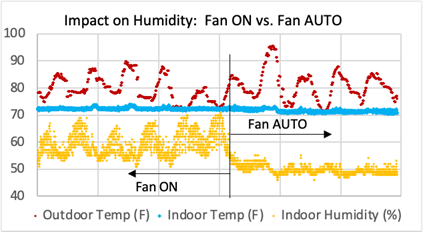Many homeowners operate their HVAC system with the fan running year-round to minimize temperature variation throughout the house, provide maximum air filtration, and/or fresh-air ventilation. It is also a practice encouraged and utilized by some HVAC contractors. Even HVAC manufacturers promote the practice by offering equipment with many constant fan speed selections or allowing the adjustment of constant fan speed from the thermostat.(1)
Unfortunately, operating the fan continuously during the summer can lead to comfort, health, and property damage risks – mainly because of high indoor humidity. The EPA states, “Sometimes, humidity or dampness (water vapor) in the air can supply enough moisture for mold growth. Indoor relative humidity (RH) should be kept below 60 percent — ideally between 30 percent and 50 percent, if possible.” (2) Now you might ask,“I thought the air conditioner dehumidifies the air, so how can operating the fan increase indoor humidity?”
Good question – and I have the answer.
The indoor humidity increases because the air flowing from the fan re-evaporates the water remaining on the cooling coil after the air conditioner shuts off. This water, known as condensate, forms when humid house air passes over the cold cooling coil; the cold coil condenses the water vapor in the air to liquid form. That is why cooling coils have a drain!
Though the condensate drains out of the cooling coil while the air conditioner is operating, much remains inside the coil and drain pan due to surface tension. When the air from the fan blows over the coil, and the air conditioner is NOT operating, the residual water is evaporated back into the air, thus raising the humidity in the air and the house. It also uses more energy as the system must dehumidify the air twice!
The graph below shows how significant this “re-evaporation” affect can be. It shows the change in humidity for a residence located in the Southeast US when the fan control is switched from ON to AUTO. It is a two-story structure where the fan ran continuously to minimize air temperature variation from upstairs to downstairs. The indoor air temperature (blue), outdoor air temperature (red), and indoor relative humidity (gold) are shown the week before, and the week after, the fan setting was changed from ON to AUTO.

With the Fan ON, the humidity ranged from ~55% to 70%, easily exceeding the EPA’s recommended 60% limit. With the fan on AUTO, humidity held close to a more reasonable 50%. Indoor and outdoor conditions were similar during both periods, and no other system changes were made other than the fan setting. The results are quite dramatic.
How to Minimize the Risk of Humidity
If you want to maintain as much air circulation as possible and minimize the risk of high humidity, there are some alternative approaches to switching the fan to AUTO:
- Consider a thermostat that allows you to run the fan for a portion of each hour.(3) That way, if the weather is mild and there is no call for cooling, you have a minimum amount of air circulation. You would have to experiment with different hourly run-time settings so that the peak humidity is not excessive. When the weather is hot, however, you will have good air circulation because the air conditioner will be running.
- If operating the fan for a small portion of each hour is not acceptable, another approach is to wire a humidistat in the Fan circuit between the thermostat to the air handler (the ‘R-G’ circuit in HVAC lingo). (4) The humidity setpoint can be set to shut the fan off at ~55-60% relative humidity and prevent problems resulting from excessively high humidity levels.
- Most all air handlers and gas furnaces operate the fan for 60 to 90 seconds after the end of the cooling cycle to remove residual “cold” from the cooling coil. This helps the manufacturer maximize the SEER efficiency rating. However, in the process of removing the “cold”, residual condensate is also re-evaporated. Some manufacturers offer a means to disable this time delay. Though it will pay a small penalty in energy efficiency, it will help minimize humidity and avoid the energy used to dehumidify the moisture evaporated into the air.
- Lastly, one air conditioner manufacturer offers a control option can be configured for a drain-down period at the end of the cooling cycle. When operating with Fan ON, the fan is held off for a period to reduce the amount of residual condensate on the cooling coil. (5) Surface tension, however, will prevent complete drainage of condensate from the coil after the fan shuts off.
Dan Dempsey is the retired Senior Technical Fellow of Residential Systems, and former Director of Heating Products Development, for Carrier Corporation, formerly part of United Technologies Corporation. Dan has over 40 years’ experience in HVAC product and system design and holds over 40 US patents and patent applications in HVAC product & system design. He was the recipient of the GAMA and Carrier Engineering Award and now consults to American Heating & Air Conditioning Co, founded by his grandfather in 1936 and led by his brother Mike Dempsey.
Keywords: humidity control, dehumidification, air conditioning, fan
Notes:
- https://www.shareddocs.com/hvac/docs/1010/Public/08/01-858-655-25.pdf
- https://www.epa.gov/mold/mold-course-chapter-2#Chapter2Lesson3
- https://support.ecobee.com/hc/en-us/articles/360004798951-How-to-control-your-HVAC-system-s-fan-with-your-ecobee-thermostat
- https://customer.resideo.com/en-US/Pages/Product.aspx?cat=HonECC+Catalog&pid=H6062A1000/U
- https://www.carrier.com/residential/en/us/homeowner-resources/hvac-basics/keep_your_heat_and_humidity_at_a_manageable_level_with_carrier_technology.html





